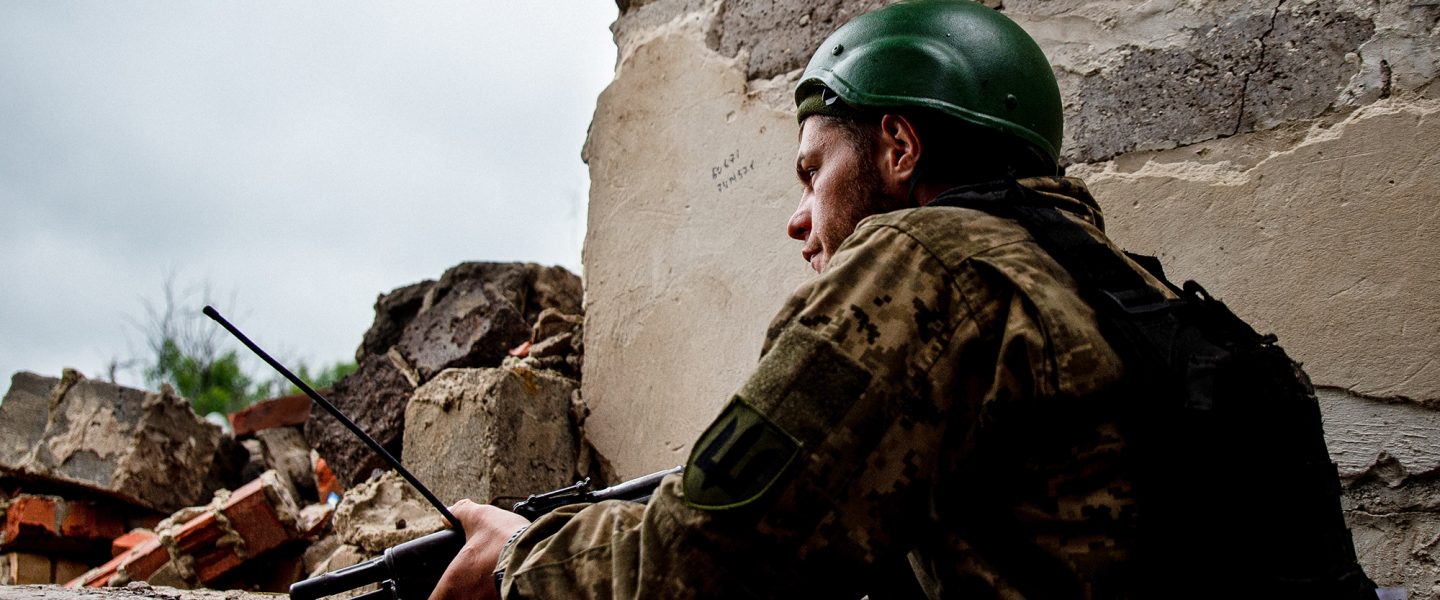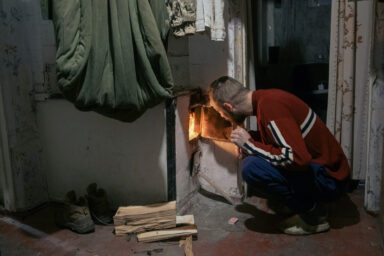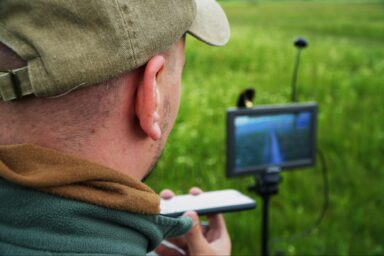Russian mortars, bombs and drones, along with sticky black mud — on the edge of the front line in Eastern Ukraine, those are the enemies of Ukraine’s oldest brigade, hunkered down for the counteroffensive.
|
Listen To This Story
|
NEW YORK, Ukraine — On a dull, gray morning in May, two photographers and I found ourselves speeding down a potholed road leading towards the small coal-mining town of New York, in eastern Ukraine. Unlike its bustling eponym, this village of less than 10,000 inhabitants is now eerily empty, save for a few elderly people riding their bicycles or pushing carts filled with bottled water. For months, New York has sat on the very edge of the front line in eastern Ukraine, and an extensive network of trenches and fortified positions now crisscross the outskirts of the town.
As we drove past the burnt-out shell of a white civilian car, Oleksii, a press-officer of the 24th Mechanized Brigade, told us that the car had been hit, just the day before, by a Russian lancet loitering munition. “The driver had his arm and leg torn out. He died instantly,” Oleksii said, his face a blank mask.
For a few tense seconds, as we drove down a hill facing occupied Horlivka, we were in full view of the Russian positions 6 miles away. With a sense of relief we veered off onto a road into the village of New York, heading towards the eastern edge of town. Gray clouds were hanging low overhead, and the ominous rumbling of artillery echoed in the distance. We pulled into a side street and parked the car in a treeline. The soldiers escorting us asked that we walk under the relative cover of the trees, and that we keep a distance of 5 to 10 yards between each person — a precaution to minimize the number of casualties if a shell were to land nearby.
Our surroundings became more dreary with every step as we walked towards the zero line — the last Ukrainian-held positions facing Russian trenches. The dirt road was lined on both sides with destroyed houses and burned garages, and collapsed power lines snaked across our path. “When we brought journalists here a month ago, most of the houses were still intact,” said “Zaryad,” the commanding officer of the company.
We stepped cautiously around the shellholes that dotted the street. After what felt like an eternity, we finally reached the end of the road. A soldier wearing rubber boots led us through a maze of rubble-covered backyards and blown-out fences. We paused at a fortified position covered with camo netting. “We’ll have to go fast, as they can see us,” said Zaryad. He pointed to our destination, an unremarkable ruined house on the other side of the street, with a flight of stairs leading to a basement.

As we entered the basement, we were greeted warmly by three soldiers in full combat gear, who offered to show us around the position. “It’s not very pretty, but at least it’s safe,” said Stanislav, one of the soldiers. He had volunteered to fight at the beginning of Russia’s invasion of Ukraine. For the past four weeks, he and his comrades had been manning this fortified position, fending off occasional probes by Russian soldiers — who were only 550 yards away — trying to circumvent their defenses. “They usually send groups of four or five soldiers towards our positions,” Stanislav added, “to locate our defenses and correct artillery fire on us.”
While the area had been the site of fierce fighting over the past months, the lines had stayed more or less stable in recent weeks, he told us. Yet artillery remains a constant threat. “They use everything here,” added Zaryad, between two drags on his cigarette, referring to the Russians. “Mortars, heavy artillery, machine guns. But the worst is probably the plane-dropped bombs and multiple rocket-launchers on civilian areas.”
The soldiers also have to stay on the lookout for “birds,” as drones are colloquially known among Ukrainian soldiers. Both the Ukrainian and Russian armies use small, inexpensive UAVs to locate enemy soldiers and vehicles and correct the trajectory of artillery. One of those UAVs had been spotted flying overhead just minutes ago. As we talked with Stanislav and his comrades, one soldier remained on the lookout at the top of the stairs, occasionally peering around the corner towards the Russian positions.

The men of the 24th also now had a new enemy: a black, treacherous mud that threatens to swallow your shoes and stains everything it touches. It had been raining for days in the Donbas, and the collapsed building provided meager cover against the elements. Water was seeping through the roof, which was constructed of cracked concrete slabs held in place by haphazard scaffolding, and the entire place was damp and muddy. A slippery tunnel dug through the walls of the basement allowed the soldiers to move unseen between the trenches and the relative safety of the position. Each trip through its dark maze coated the soldiers’ clothing and weapon with a thick layer of mud. Outside, shells could be heard whistling overhead before crashing down in the distance.

In recent days, a string of offensive operations along various points of the front line have been deemed by analysts to be the beginning of Ukraine’s long-awaited counteroffensive. After a week of heavy fighting, the Ukrainian army reported on Wednesday the liberation of seven villages on the southeastern front. However, the Ukrainians have incurred losses — including Western-supplied weaponry — and they have yet to reach the main line of Russian defenses, which analysts have called the most extensive network of fortifications in Europe since World War II. As for the men manning the trenches of the Donbas, the prospect of a swift end to the war remains remote. “We can’t afford to step back; we can only move forward,” Zaryad said.




